Integrated HBIM-GIS Models for Multi-Scale Seismic Vulnerability Assessment of Historical Buildings
Abstract
1. Introduction
1.1. Research Motivation
1.2. Urban Centres and Seismic Damage Assesment: A Reflection upon Churches Heritage in the Italian Law
1.3. User-Oriented Urban 3D Geodatabases
2. Material and Methods
2.1. The Workflow
2.2. Reflections on Similarities Detected on Two Standards: LoD (CityGML) and LOD (IFC)
- LoD 0, is for the regional and landscape level, it corresponds to the maximum generalization, a 2D polygon represents the shape of a building;
- LoD 1. Regional or city level (1:25000/1:10000 scale), the accuracy is low (5 m to 2 m), the buildings are represented as schematic volume, and the roofs are flat;
- LoD 2, is for city district and urban context, (1:5000/ 1:1000 scale) the accuracy is medium (2 m–1 m). The buildings have roof objects with their shape and orientation;
- LoD 3. In the LoD 3 the exterior architectural models (1:1000/1:500 scale) are represented and the accuracy is high. The buildings are represented in the actual form as are the roofs;
- LoD 4 in CityGML 2.0 enhances the previous LoD adding the interior architectural model structures (more than 1:500), but currently LoD 4 (CityGML 3.0) can be used in any lower LoD.
2.3. Data Collection: Integrated Rapid Mapping Approach Supporting Damage Mapping and Seismic Vulnerability Assessment
2.3.1. Cases Studies
Urban Scale: The Norcia Urban Centre
Architectural Scale: The Sant’Andrea Church Digital Model
- Damage inspection and deformation analysis;
- Monitoring of the evolution of deformations and damages by analyzing and comparing different measurements, from a multi-temporal and multi-scale point of view;
- The definition of volumes for analysis aimed at the identification of the elements that make up the architectural system and the conditions of equilibrium.
3. Results
3.1. From Point Clouds to Structured Models
3.2. Urban Scale HBIM Modeling
3.2.1. LoDs
LoD 0 Modelling
LoD 1 Modelling (LOD 100)
LoD 2-3 (LOD 200-300)
- IFC object types in LoD 2 (LOD 200): ifcwall, ifc roof;
- IFC object types in LoD 3 (LOD 300): ifcWall, ifc Roof, ifcDoor, Ifcwindow, ifcstair.
LoD 3 Interior (cityGML 3.0) (LoD 4CityGML 2.0) (LOD 400)
- IFC object types in LoD 4 (LOD 400): ifcWall, ifc Roof, ifcDoor, Ifcwindow, ifcstair, InteriorWallSurface.
3.3. Architectural Scale: 3D Multisensor Model Generation
- Archival and historical data supporting the knowledge of pre-earthquake condition;
- Images datasets captured by UAVs offer a privileged point of view, from above in nadir view and according to different camera positions and orientation, both for an inspection from inaccessible viewpoints and for a complete modelling and representation of the building façades;
- Orthophotos and two-dimensional elaborations (Figure 9) in the form of sections and elevations in scale where the geometric and radiometric data are harmonized and metrically controlled;
- Textured 3D mesh models, generated from the transformation of the point cloud, is formed by vertices, which identify edges and faces (Figure 10). In addition, the texture derived from the re-projected frames with metric control can be applied to the external surfaces; the result can be delivered as a 3D parametric model navigable for analysis of the artifact by conservation experts (Figure 11 and Figure 12);
- The complete 3D volumetric model characterized by simplified geometries allowing the analyses for identifying the conditions of equilibrium (Figure 13).
3.3.1. Volumetric Model for the Macro-Elements Analysis
3.3.2. 3D Model Validation for Seismic Vulnerability Assessment
The Directive Method Application: An Example
4. Discussion
4.1. The User-Fruition Improvement of the Multi-Scale 3D Geodatabase
- -
- 3D multiscale information structuring according to macroelements and elements;
- -
- Analysis of geographical scale phenomena according to Directive modules and level of evaluation;
- -
- Applicability of dashboard interfaces for information querying.
4.2. Applicability of Macroelement Analysis in HBIM-GIS Models for a Geographic Scale Perspective
- -
- The Building object must be characterized by LoD.
- -
- Macroelements are considered Building Part, defined by INSPIRE as “sub-division of a Building that might be considered itself as a building”.
- -
- Macroelement names must comply with the AAT Getty Vocabularies for unambiguous definition.
4.3. Future Perspectives on Data Readiness by AMS Interfaces
5. Conclusions
Author Contributions
Funding
Acknowledgments
Conflicts of Interest
References
- Stewart, J.P.; Zimmaro, P.; Lanzo, G.; Mazzoni, S.; Ausilio, E.; Aversa, S.; Bozzoni, F.; Cairo, R.; Capatti, M.C.; Castiglia, M.; et al. Reconnaissance of 2016 Central Italy Earthquake Sequence. Earthq. Spectra 2018, 34, 1547–1555. [Google Scholar] [CrossRef]
- Ferreira, T.M.; Mendes, N.; Silva, R. Multiscale Seismic Vulnerability Assessment and Retrofit of Existing Masonry Buildings. Buildings 2019, 9, 91. [Google Scholar] [CrossRef]
- Zlatanova, S. SII for Emergency Response: The 3D Challenges. Proc. XXI ISPRS Congr. 2008, XXXVII, 1631–1638. [Google Scholar]
- Romis, F.; Caprili, S.; Salvatore, W.; Ferreira, T.M.; Lourenço, P.B. Seismic Vulnerability Assessment of Historical Urban Centres: The Case Study of Campi Alto Di Norcia, Italy. Int. Arch. Photogramm. Remote Sens. Spat. Inf. Sci. 2020, XLIV-M-1–2020, 885–892. [Google Scholar] [CrossRef]
- Romis, F.; Caprili, S.; Salvatore, W.; Ferreira, T.M.; Lourenço, P.B. An Improved Seismic Vulnerability Assessment Approach for Historical Urban Centres: The Case Study of Campi Alto Di Norcia, Italy. Appl. Sci. 2021, 11, 849. [Google Scholar] [CrossRef]
- Grazzini, A.; Chiabrando, F.; Foti, S.; Sammartano, G.; Spanò, A. A Multidisciplinary Study on the Seismic Vulnerability of St. Agostino Church in Amatrice Following the 2016 Seismic Sequence. Int. J. Archit. Herit. 2020, 14, 885–902. [Google Scholar] [CrossRef]
- Fernandez Galarreta, J.; Kerle, N.; Gerke, M. UAV-Based Urban Structural Damage Assessment Using Object-Based Image Analysis and Semantic Reasoning. Nat. Hazards Earth Syst. Sci. 2015, 15, 1087–1101. [Google Scholar] [CrossRef]
- Calantropio, A.; Chiabrando, F.; Sammartano, G.; Spanò, A.; Teppati Losè, L. UAV strategies validation and remote sensing data for damage assessment in post-disaster scenarios. ISPRS-Int. Arch. Photogramm. Remote Sens. Spat. Inf. Sci. 2018, 42, 121–128. [Google Scholar] [CrossRef]
- Duarte, D.; Nex, F.; Kerle, N.; Vosselman, G. Towards a More Efficient Detection of Earthquake Induced Façade Damages Using Oblique UAV Imagery. ISPRS-Int. Arch. Photogramm. Remote Sens. Spat. Inf. Sci. 2017, 42, 93–100. [Google Scholar] [CrossRef]
- Ajmar, A.; Boccardo, P.; Tonolo, F.G. Mappatura Speditiva Dei Danni Da Immagini Satellitari a Supporto Della Risposta All’ Emergenza Satellite Based Rapid Mapping to Assess Damages in Support of Emergency Management. ATTI E Rass. Tec. 2019, LXXIII, 32–40. [Google Scholar]
- Redweik, P.; Teves-Costa, P.; Vilas-Boas, I.; Santos, T. 3D City Models as a Visual Support Tool for the Analysis of Buildings Seismic Vulnerability: The Case of Lisbon. Int. J. Disaster Risk Sci. 2017, 8, 308–325. [Google Scholar] [CrossRef]
- Colucci, E.; Noardo, F.; Matrone, F.; Spanò, A.; Lingua, A. High-Level-of-Detail Semantic 3D GIS for Risk and Damage Representation of Architectural Heritage. Int. Arch. Photogramm. Remote Sens. Spat. Inf. Sci.-ISPRS Arch. 2018, 42, 177–183. [Google Scholar] [CrossRef]
- Banfi, F. BIM orientation: Grades of generation and information for different type of analysis and management process. ISPRS-Int. Arch. Photogramm. Remote Sens. Spat. Inf. Sci. 2017, 42, 57–64. [Google Scholar] [CrossRef]
- Directive 2007/2/EC Establishing an Infrastructure for Spatial Information in the European Community (INSPIRE); 2007. Available online: http://inspire.ec.europa.eu/documents/directive-20072ec-european-parliament-and-council-14-march-2007-establishing (accessed on 27 January 2023).
- Logothetis, S.; Delinasiou, A.; Stylianidis, E. Building Information Modelling for Cultural Heritage: A Review. ISPRS Ann. Photogramm. Remote Sens. Spat. Inf. Sci. 2015, 2, 177–183. [Google Scholar] [CrossRef]
- Volk, A.R.; Stengel, J.; Schultmann, F. Building Information Modeling (BIM) for Existing Buildings—Literature Review and Future Needs. Autom. Constr. 2014, 38, 109–127. [Google Scholar] [CrossRef]
- Noardo, F.; Krijnen, T.; Arroyo Ohori, K.; Biljecki, F.; Ellul, C.; Harrie, L.; Eriksson, H.; Polia, L.; Salheb, N.; Tauscher, H.; et al. Reference Study of IFC Software Support: The GeoBIM Benchmark 2019—Part I. Trans. GIS 2021, 25, 805–841. [Google Scholar] [CrossRef]
- Noardo, F.; Arroyo Ohori, K.; Biljecki, F.; Ellul, C.; Harrie, L.; Krijnen, T.; Eriksson, H.; van Liempt, J.; Pla, M.; Ruiz, A.; et al. Reference Study of CityGML Software Support: The GeoBIM Benchmark 2019—Part II. Trans. GIS 2021, 25, 842–868. [Google Scholar] [CrossRef]
- Billen, R.; Zlatanova, S. 3D Spatial Relationships Model: A Useful Concept for 3D Cadastre? Comput. Environ. Urban Syst. 2003, 27, 411–425. [Google Scholar] [CrossRef]
- Atazadeh, B.; Rajabifard, A.; Zhang, Y.; Barzegar, M. Querying 3D Cadastral Information from BIM Models. ISPRS Int. J. Geo-Inf. 2019, 8, 329. [Google Scholar] [CrossRef]
- León-Sánchez, C.; Agugiaro, G.; Stoter, J. Creation of a CityGML-Based 3D City Model Testbed for Energy-Related Appications. Int. Arch. Photogramm. Remote Sens. Spat. Inf. Sci. 2022, 48, 97–103. [Google Scholar] [CrossRef]
- Biljecki, F.; Stoter, J.; Ledoux, H.; Zlatanova, S.; Çöltekin, A. Applications of 3D City Models: State of the Art Review. ISPRS Int. J. Geo-Inf. 2015, 4, 2842–2889. [Google Scholar] [CrossRef]
- Avena, M.; Colucci, E.; Sammartano, G.; Spanò, A. HBIM modelling for an historical urban centre. Int. Arch. Photogramm. Remote Sens. Spat. Inf. Sci. 2021, 43, 831–838. [Google Scholar] [CrossRef]
- VV.AA. (Spanò ed.) L’esperienza Interdisciplinare Della Task Force Del Politecnico Di Torino per Il Terremoto Del Centro Italia (2016–2017). Sviluppi e Prospettive. ATTI E Rass. Tec. 2018, LXXIII, N. [Google Scholar]
- Crowley, H. European Exposure and Vulnerability Models: State-of-The-Practice, Challenges and Future Directions. In Advances in Assessment and Modeling of Earthquake Loss; Springer International Publishing: Cham, Switzerland, 2021; pp. 155–168. [Google Scholar]
- Crowley, H.; Dabbeek, J.; Despotaki, V.; Rodrigues, D.; Martins, L.; Silva, V.; Romão, X.; Pereira, N.; Weatherill, G.; Danciu, L. European Seismic Risk Model (ESRM20); EFEHR Technical Report 002, V1.0.1; ETH Zurich: Zürich, Switzerland, 2021; 84p. [Google Scholar] [CrossRef]
- Benedetti, D.; Benzoni, G.; Parisi, M.A. Seismic Vulnerability and Risk Evaluation for Old Urban Nuclei. Earthq. Eng. Struct. Dyn. 1988, 16, 183–201. [Google Scholar] [CrossRef]
- Kassem, M.M.; Nazri, F.M.; Farsangi, E.N.; Ozturk, B. Improved Vulnerability Index Methodology to Quantify Seismic Risk and Loss Assessment in Reinforced Concrete Buildings. J. Earthq. Eng. 2022, 26, 6172–6207. [Google Scholar] [CrossRef]
- Putrino, V.; D’Ayala, D. Effectiveness of Seismic Strengthening to Repeated Earthquakes in Historic Urban Contexts: Norcia 2016. Disaster Prev. Manag. An Int. J. 2020, 29, 47–64. [Google Scholar] [CrossRef]
- Lagomarsino, S.; Podestà, S. Seismic Vulnerability of Ancient Churches: I. Damage Assessment and Emergency Planning. Earthq. Spectra 2004, 20, 377–394. [Google Scholar] [CrossRef]
- Lagomarsino, S.; Podestà, S. Seismic Vulnerability of Ancient Churches: II. Statistical Analysis of Surveyed Data and Methods for Risk Analysis. Earthq. Spectra 2004, 20, 395–412. [Google Scholar] [CrossRef]
- NIKER. 2010. Available online: http://cordis.europa.eu/project/id/244123/reporting/it (accessed on 27 January 2023).
- Bruno, N.; Roncella, R. HBIM for Conservation: A New Proposal for Information Modeling. Remote Sens. 2019, 11, 1751. [Google Scholar] [CrossRef]
- Murphy, M.; McGovern, E.; Pavia, S. Historic Building Information Modelling—Adding Intelligence to Laser and Image Based Surveys of European Classical Architecture. ISPRS J. Photogramm. Remote Sens. 2013, 76, 89–102. [Google Scholar] [CrossRef]
- Brumana, R.; Della Torre, S.; Previtali, M.; Barazzetti, L.; Cantini, L.; Oreni, D.; Banfi, F. Generative HBIM Modelling to Embody Complexity (LOD, LOG, LOA, LOI): Surveying, Preservation, Site Intervention—The Basilica Di Collemaggio (L’Aquila). Appl. Geomat. 2018, 10, 545–567. [Google Scholar] [CrossRef]
- De Luca, L.; Busayarat, C.; Stefani, C.; Véron, P.; Florenzano, M. A Semantic-Based Platform for the Digital Analysis of Architectural Heritage. Comput. Graph. 2011, 35, 227–241. [Google Scholar] [CrossRef]
- Brumana, R.; Ioannides, M.; Previtali, M. Holistic heritage building information modelling (hhbim): From nodes to hub networking, vocabularies and repositories. Int. Arch. Photogramm. Remote Sens. Spat. Inf. Sci. 2019, 42, 309–316. [Google Scholar] [CrossRef]
- Laurini, R. A Conceptual Framework for Geographic Knowledge Engineering. J. Vis. Lang. Comput. 2014, 25, 2–19. [Google Scholar] [CrossRef]
- Isikdag, U.; Zlatanova, S. Towards Defining a Framework for Automatic Generation of Buildings in CityGML Using Building Information Models. In 3D Geo-Information Sciences; Springer: Berlin/Heidelberg, Germany, 2009; pp. 79–96. [Google Scholar]
- Xu, X.; Ding, L.; Luo, H.; Ma, L. From Building Information Modeling to City Information Modeling. J. Inf. Technol. Constr. 2014, 19, 292–307. [Google Scholar] [CrossRef]
- Colucci, E.; De Ruvo, V.; Lingua, A.; Matrone, F.; Rizzo, G. HBIM-GIS Integration: From IFC to CityGML Standard for Damaged Cultural Heritage in a Multiscale 3D GIS. Appl. Sci. 2020, 10, 1356. [Google Scholar] [CrossRef]
- Yang, X.; Lu, Y.-C.; Murtiyoso, A.; Koehl, M.; Grussenmeyer, P. HBIM Modeling from the Surface Mesh and Its Extended Capability of Knowledge Representation. ISPRS Int. J. Geo-Inf. 2019, 8, 301. [Google Scholar] [CrossRef]
- Colucci, E.; Xing, X.; Kokla, M.; Mostafavi, M.A.; Noardo, F.; Spanò, A. Ontology-Based Semantic Conceptualisation of Historical Built Heritage to Generate Parametric Structured Models from Point Clouds. Appl. Sci. 2021, 11, 2813. [Google Scholar] [CrossRef]
- Meschini, S.; Accardo, D.; Avena, M.; Seghezzi, E.; Tagliabue, C.L.; Di Giuda, G.M. Data Integration through a Bim-GIS Web Platform for the Management of Diffused University Assets. In Proceedings of the 2022 European Conference on Computing in Construction, Ixia, Rhodes, Greece, 24–26 July 2022. [Google Scholar] [CrossRef]
- Building SMART International IFC Specifications Database 2023. Available online: http://technical.buildingsmart.org/standards/ifc/ifc-schema-specifications/ (accessed on 27 January 2023).
- Tolmer, C.-E.; Castaing, C.; Diab, Y.; Morand, D. CityGML and IFC: Going Further than LOD. In Proceedings of the 2013 Digital Heritage International Congress (DigitalHeritage), Marseille, France, 28 October–1 November 2013; pp. 645–648. [Google Scholar]
- UNI EN 17412-1:2021; Building Information Modelling—Livello Di Fabbisogno Informativo—Parte 1: Concetti e Principi 2021. UNI: Milan, Italy, 2021.
- Di Giuda, G.M. Introduzione Al BIM: Protocolli Di Modellazione e Gestione Informativa; Società Ed.: Rome, Italy, 2019. [Google Scholar]
- UNI EN ISO 19650-1:2018; Building Information Modelling (BIM)—Gestione Informativa Mediante Il Building Information Modelling—Parte 1: Concetti e Principi 2019. UNI: Milan, Italy, 2018.
- Biljecki, F.; Ledoux, H.; Stoter, J. An Improved LOD Specification for 3D Building Models. Comput. Environ. Urban Syst. 2016, 59, 25–37. [Google Scholar] [CrossRef]
- Sammartano, G. Suitability of 3D Dense Models from Rapid Mapping Strategies for Cultural Heritage Documentation and Conservation. Validation of Metric and Non-Metric Information Extraction from Integrated Solutions. Ph.D. Thesis, DAD—Politecnico di Torino, Torino, Italy, 2018. [Google Scholar]
- Pagana, P. Sismicità Storica in Umbria. Ricostruzione e Studio Dei Principali Terremoti Verificatisi a Partire Dal III Secolo a.C.; Firenze University Press: Perugia, Italy, 2011. [Google Scholar]
- Avena, M. Dalla Nuvola Di Punti All’UrbanBIM. Tecniche Integrate Di Rilievo 3D per La Generazione Di Un Modello Multiscala Di Città in Scenario Post Sismico. Il Caso Studio Di Norcia (PG), Rel. A. Spanò, E. Abbate. Master’s Thesis, Politecnico di Torino, Torino, Italy, 2020. [Google Scholar]
- Fillia, E. Modelli 3D per La Valutazione Della Vulnerabilità Sismica Delle Chiese in Muratura Storica. Il Caso Studio Di Sant’Andrea a Campi Di Norcia., Rel. A. Spanò. C. Tocci, G. Sammartano. Master’s Thesis, Politecnico di Torino, Torino, Italy, 2020. [Google Scholar]
- Treccani, D.; Balado, J.; Fernández, A.; Adami, A.; Díaz-Vilariño, L. A Deep Learning Approach for the Recognition of Urban Ground Pavements in Historical Sites. Int. Arch. Photogramm. Remote Sens. Spat. Inf. Sci. 2022, 43, 321–326. [Google Scholar] [CrossRef]
- Matrone, F.; Grilli, E.; Martini, M.; Paolanti, M.; Pierdicca, R.; Remondino, F. Comparing Machine and Deep Learning Methods for Large 3D Heritage Semantic Segmentation. ISPRS Int. J. Geo-Inf. 2020, 9, 535. [Google Scholar] [CrossRef]
- Croce, V.; Caroti, G.; Piemonte, A.; Bevilacqua, M.G. From Survey to Semantic Representation for Cultural Heritage: The 3D Modeling of Recurring Architectural Elements. Acta IMEKO 2021, 10, 98. [Google Scholar] [CrossRef]
- Grilli, E.; Remondino, F. Classification of 3D Digital Heritage. Remote Sens. 2019, 11, 847. [Google Scholar] [CrossRef]
- Zhang, W.; Qi, J.; Wan, P.; Wang, H.; Xie, D.; Wang, X.; Yan, G. An Easy-to-Use Airborne LiDAR Data Filtering Method Based on Cloth Simulation. Remote Sens. 2016, 8, 501. [Google Scholar] [CrossRef]
- Hichri, N.; Stefani, C.; De Luca, L.; Veron, P. Review of the « As-Built Bim » Approaches. 3D-ARCH 2013—3D Virtual Reconstr. Vis. Complex Archit. 2013, XL-5/W1, 107–112. [Google Scholar] [CrossRef]
- Tang, P.; Huber, D.; Akinci, B.; Lipman, R.; Lytle, A. Automatic Reconstruction of As-Built Building Information Models from Laser-Scanned Point Clouds: A Review of Related Techniques. Autom. Constr. 2010, 19, 829–843. [Google Scholar] [CrossRef]
- Brumana, R.; Stanga, C.; Banfi, F. Models and Scales for Quality Control: Toward the Definition of Specifications (GOA-LOG) for the Generation and Re-Use of HBIM Object Libraries in a Common Data Environment. Appl. Geomat. 2022, 14, 151–179. [Google Scholar] [CrossRef]
- Fillia, E.; Sammartano, G.; Tocci, C. Spanò Modellare La Conoscenza Della Vulnerabilità Sismica Delle Chiese in Muratura Storica Con Tecnologie 3D Speditive Introduzione. In Proceedings of the Conferenza ASITA 2021, Genoa, Italy, 1–23 July 2021; pp. 167–180. [Google Scholar]
- Sammartano, G.; Avena, M.; Cappellazzo, M.; Spanò, A. Hybrid GIS-BIM approach for the Torino digital-twin: The implementation of a floor-level 3D city geodatabase. Int. Arch. Photogramm. Remote Sens. Spat. Inf. Sci. 2021, 43, 423–430. [Google Scholar] [CrossRef]
- Shaulska, L.; Yurchyshena, L.; Popovskyi, Y. Using MS Power BI Tools in the University Management System to Deepen the Value Proposition. In Proceedings of the 2021 11th International Conference on Advanced Computer Information Technologies (ACIT), Deggendorf, Germany, 15–17 September 2021; pp. 294–298. [Google Scholar] [CrossRef]
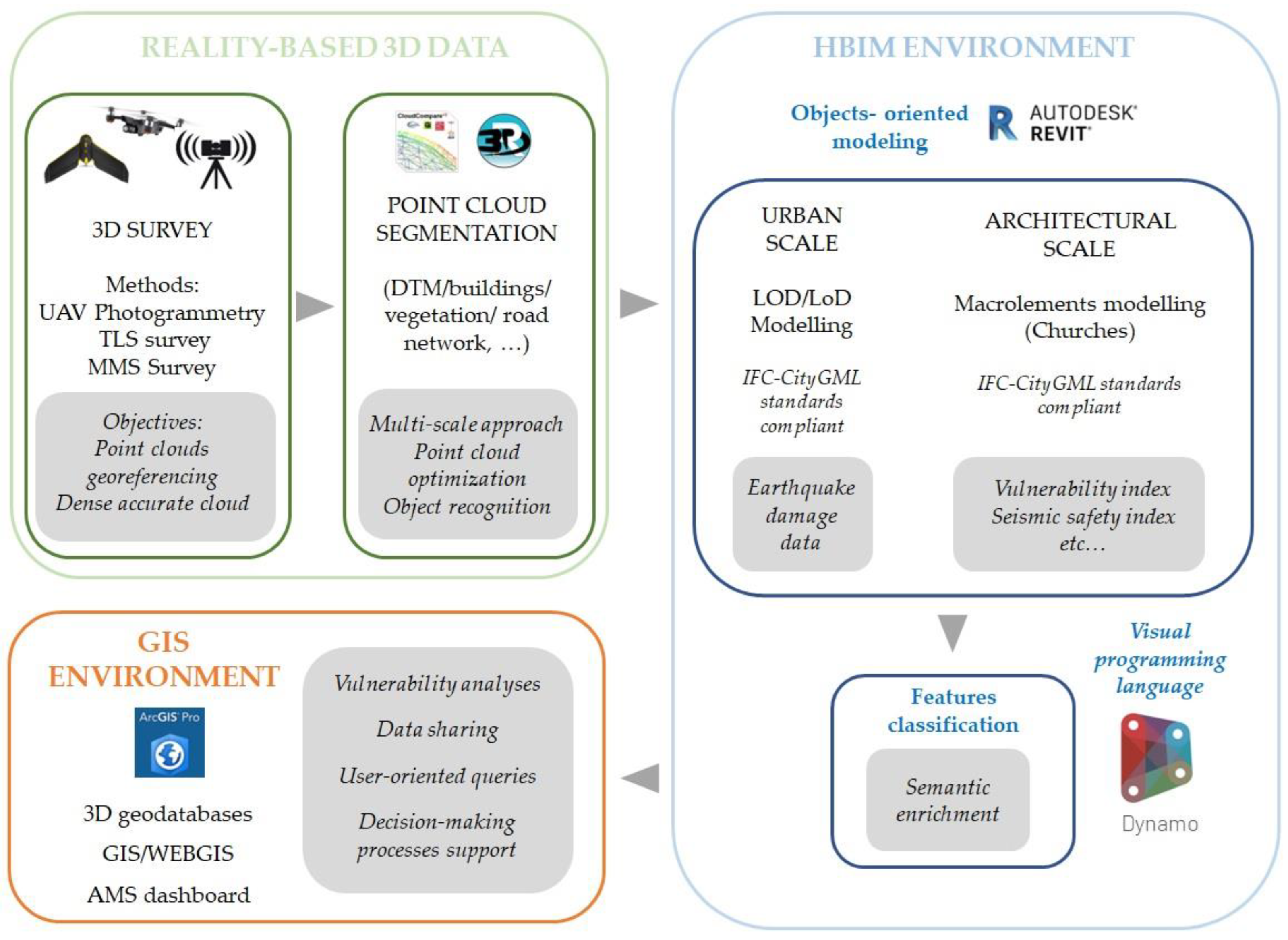
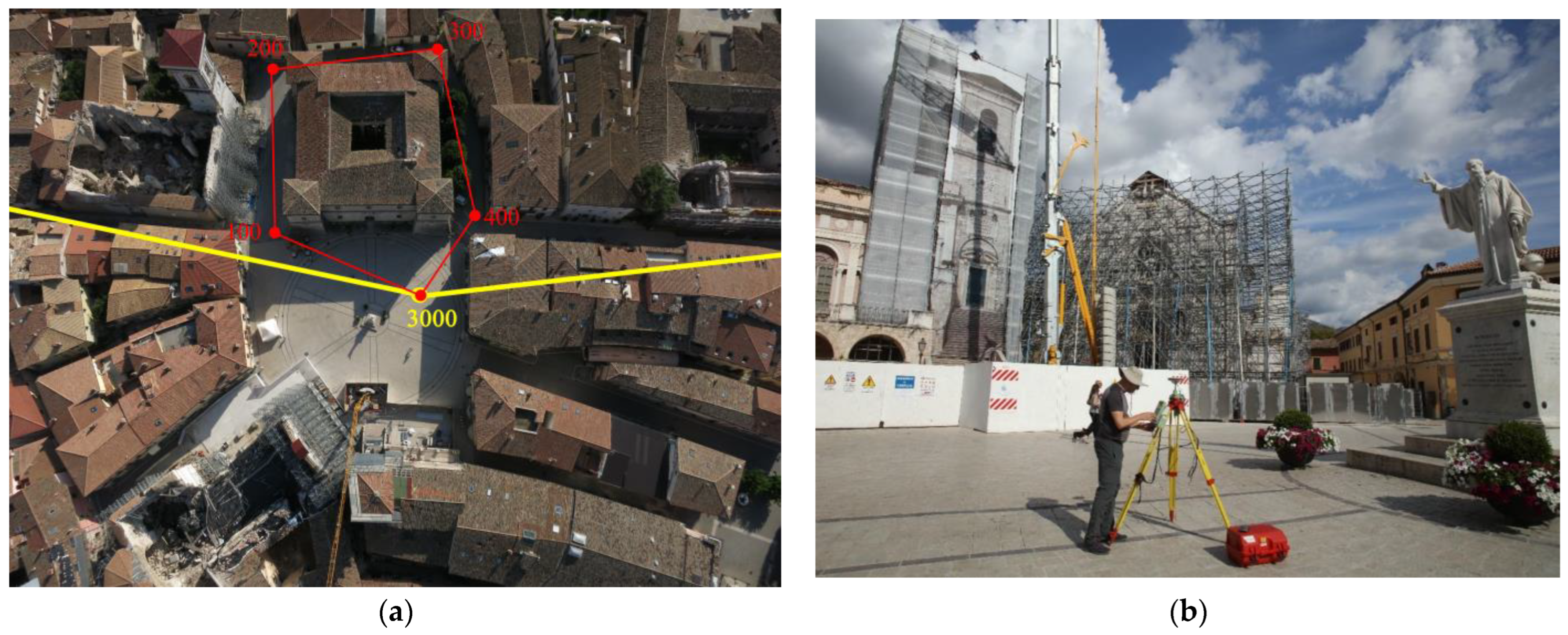
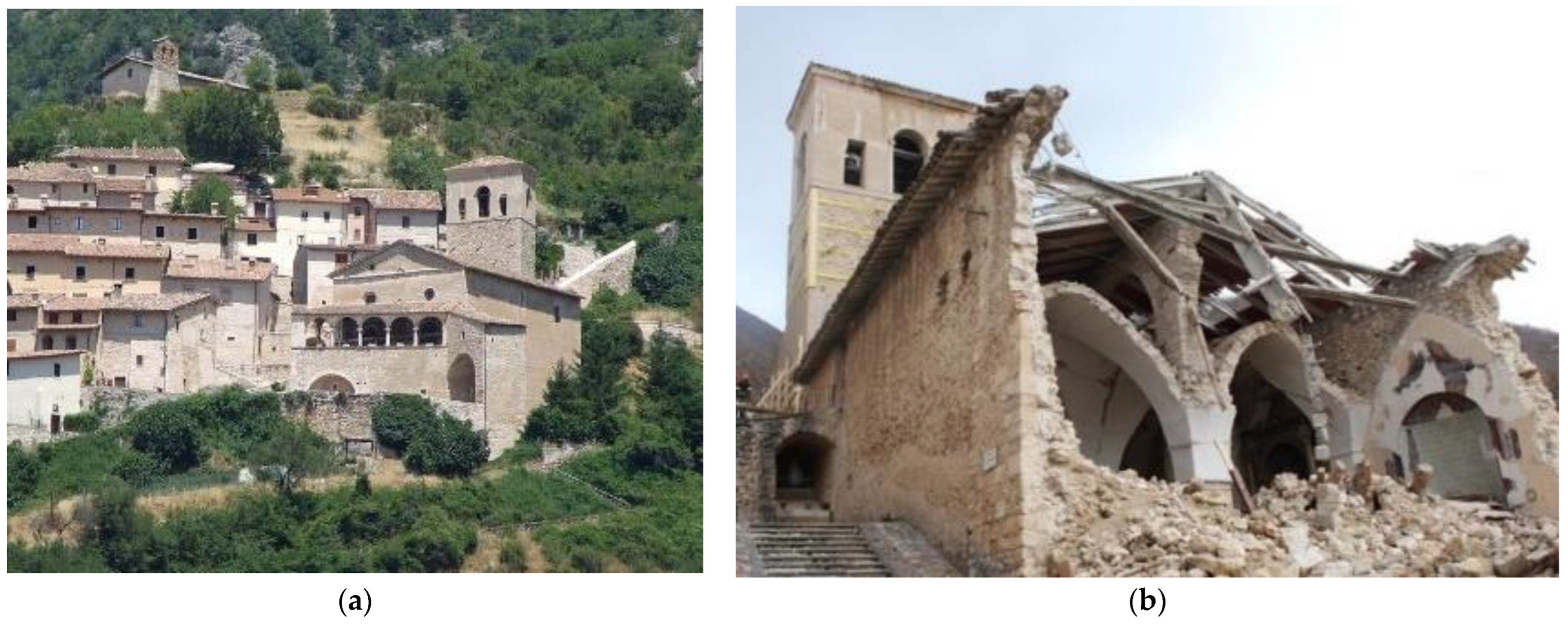
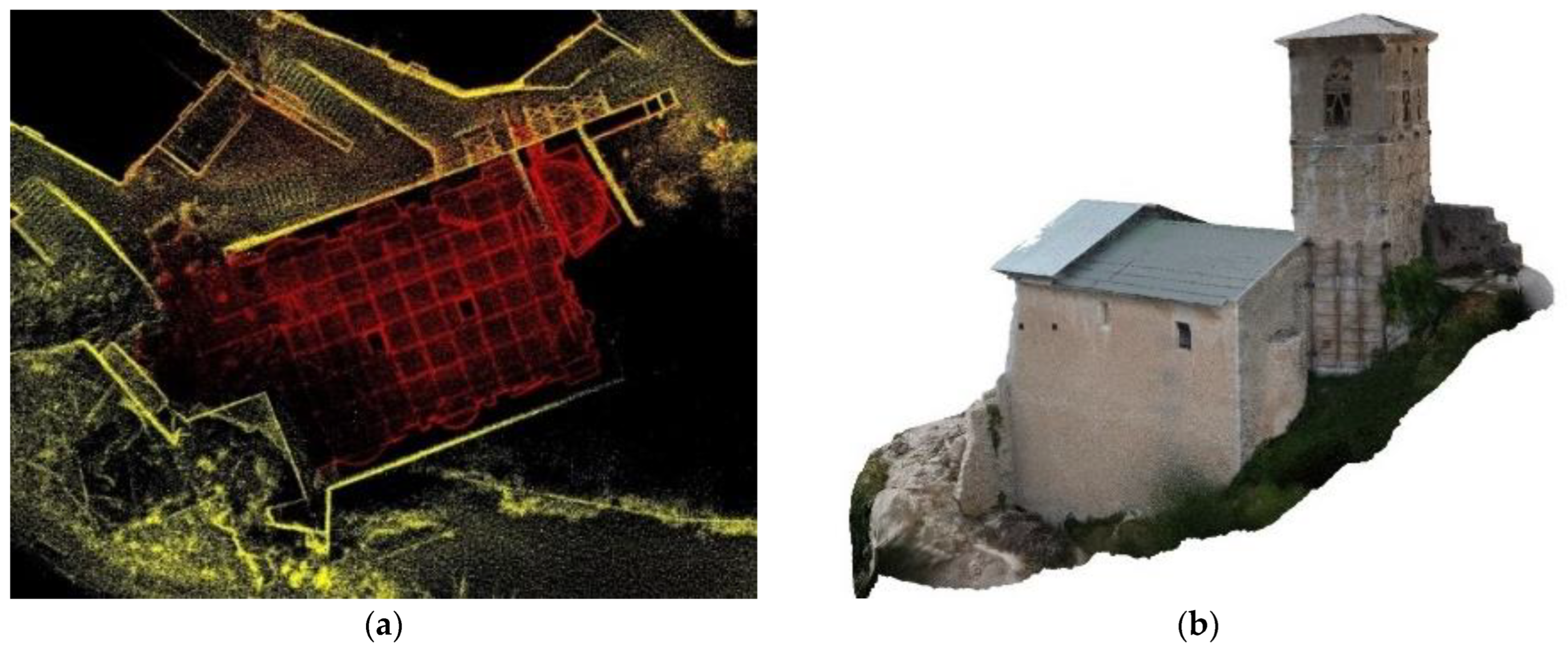
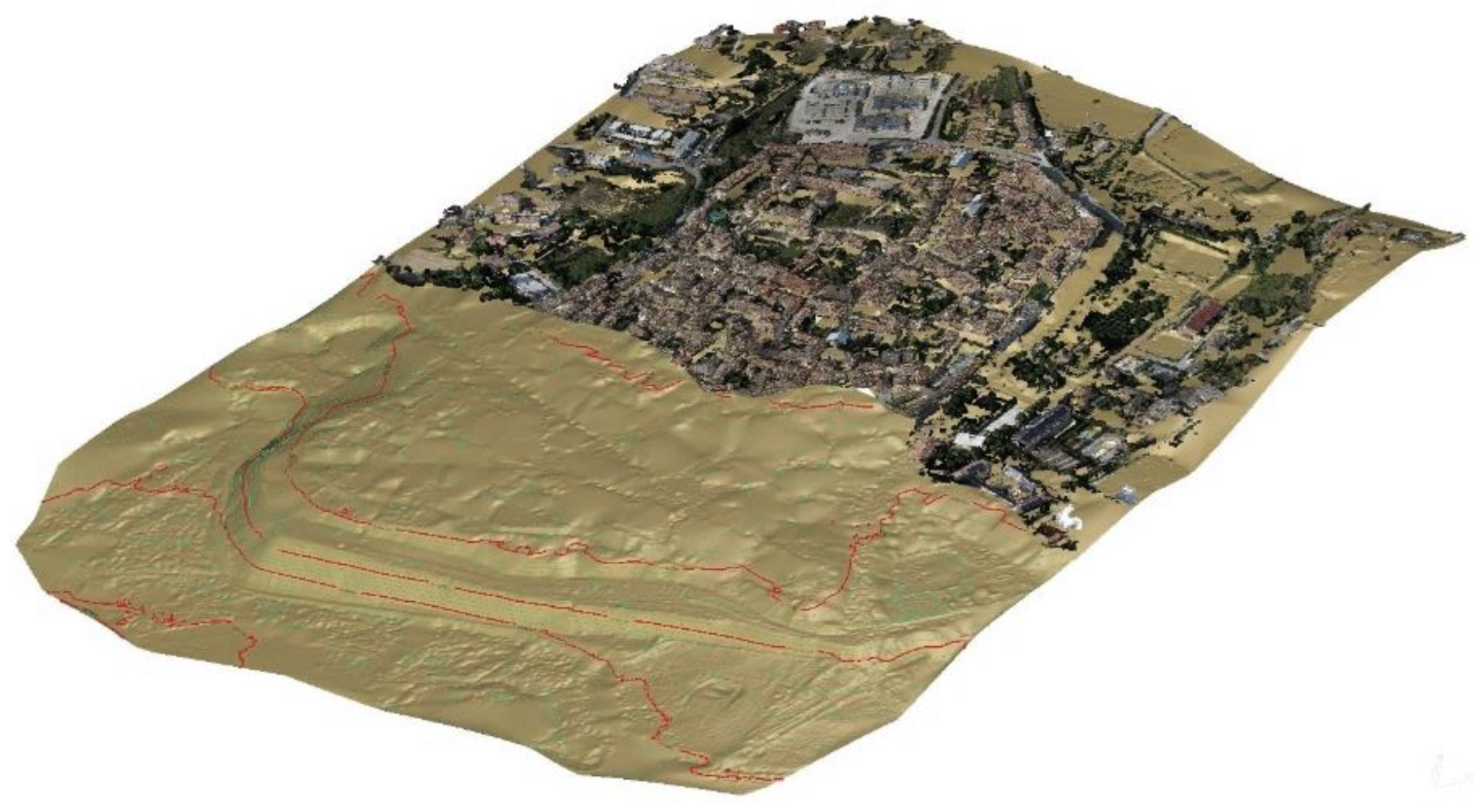
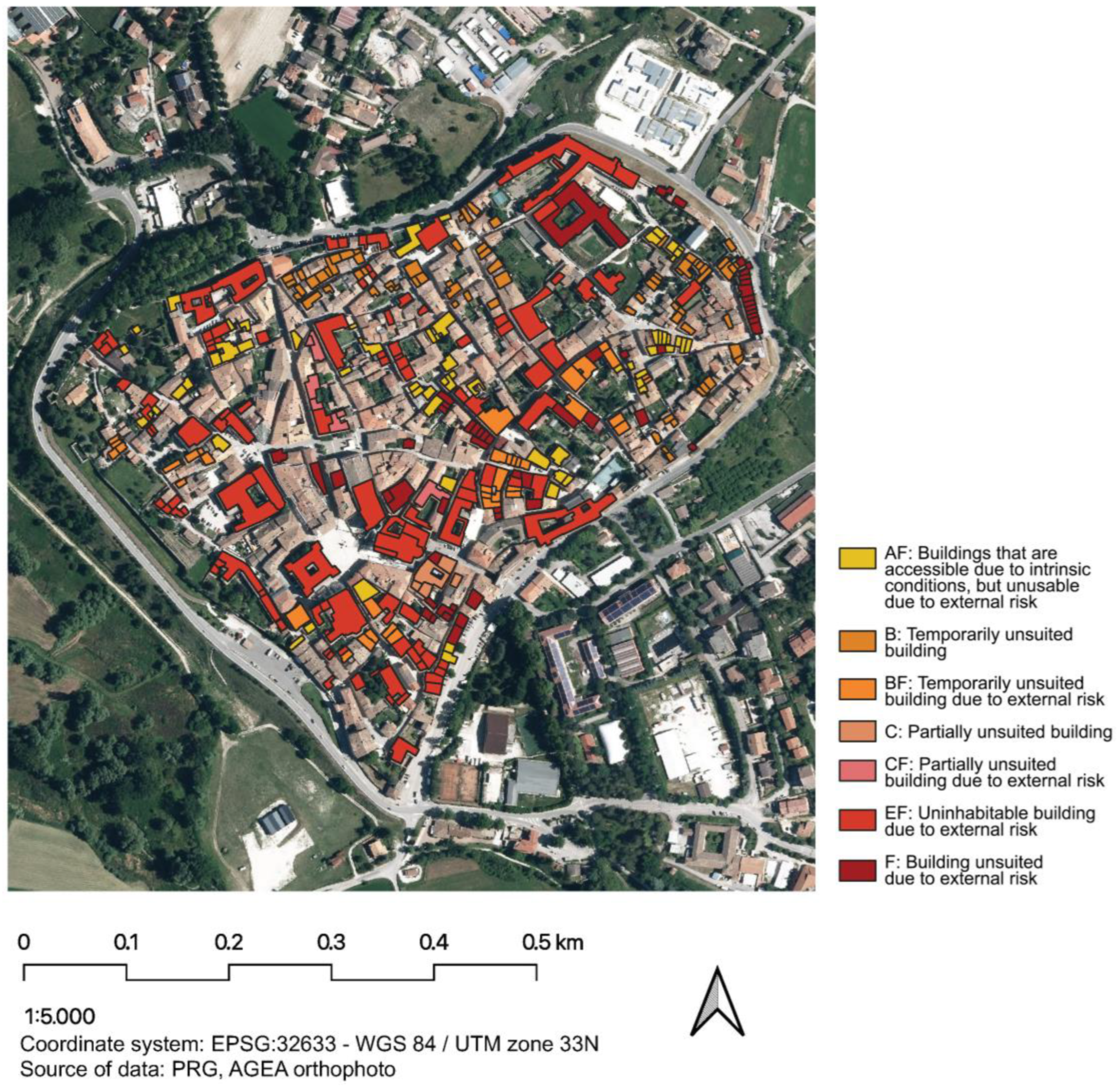
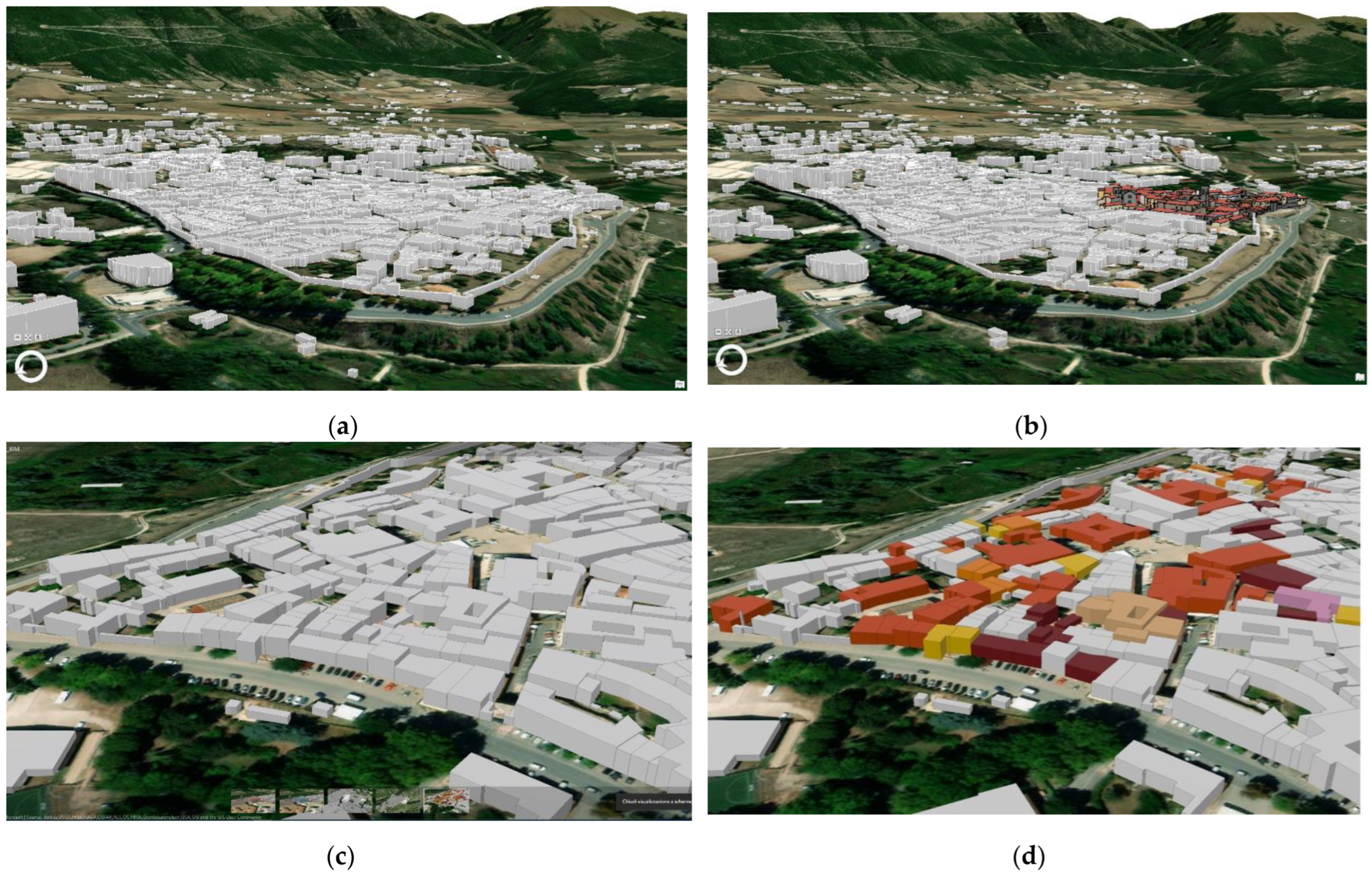
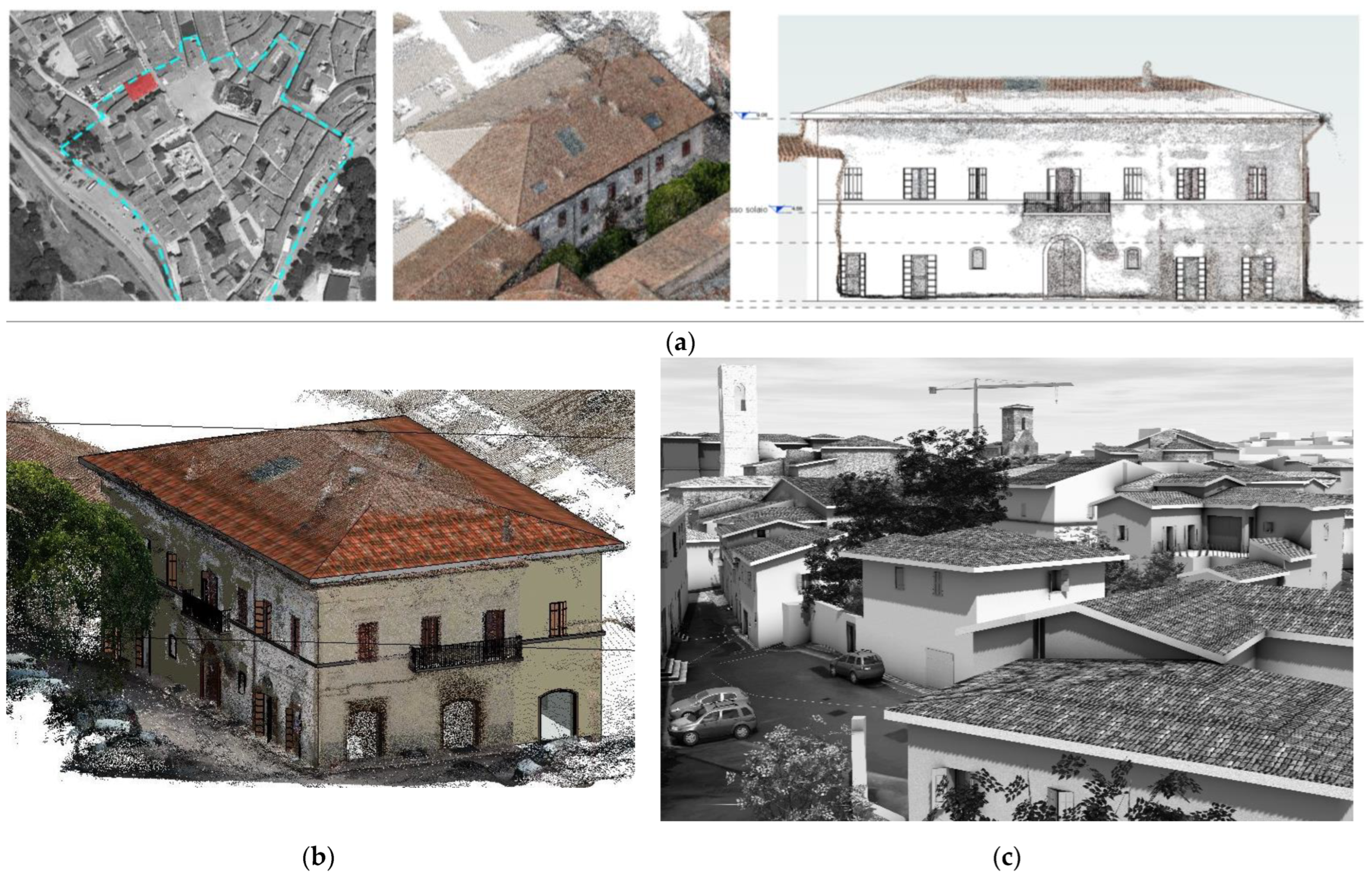
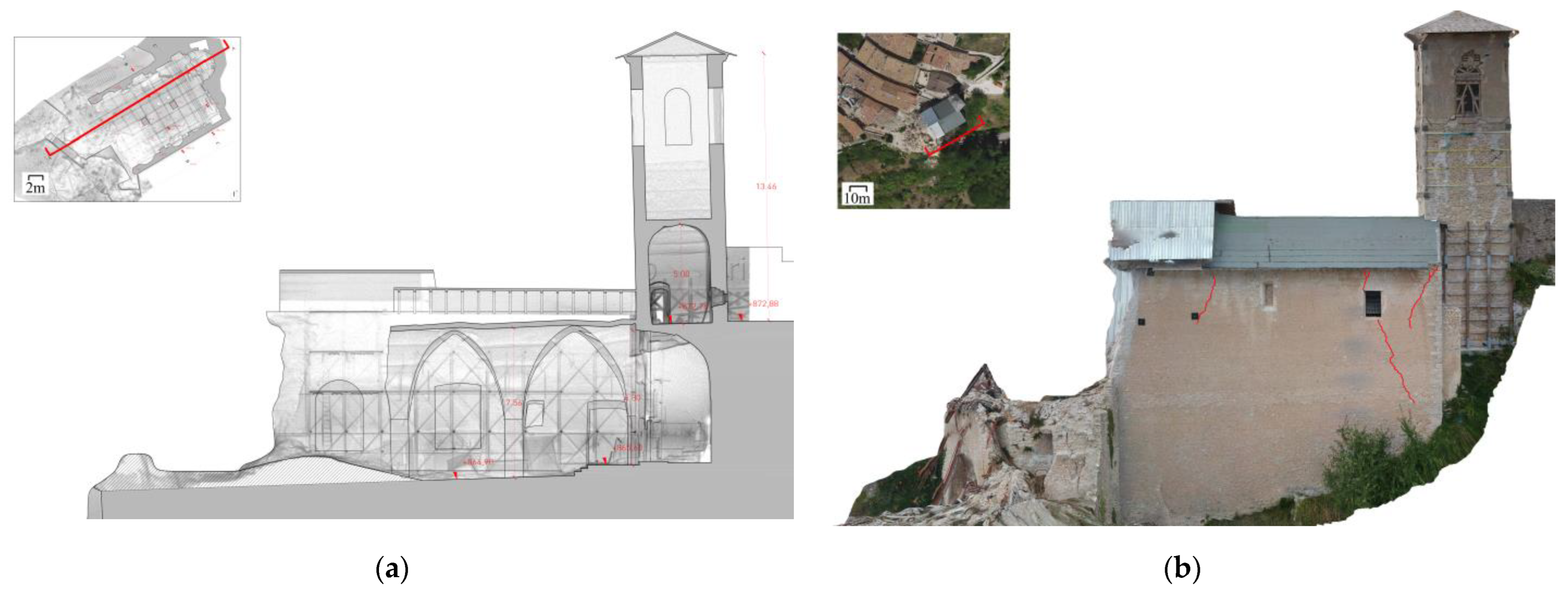
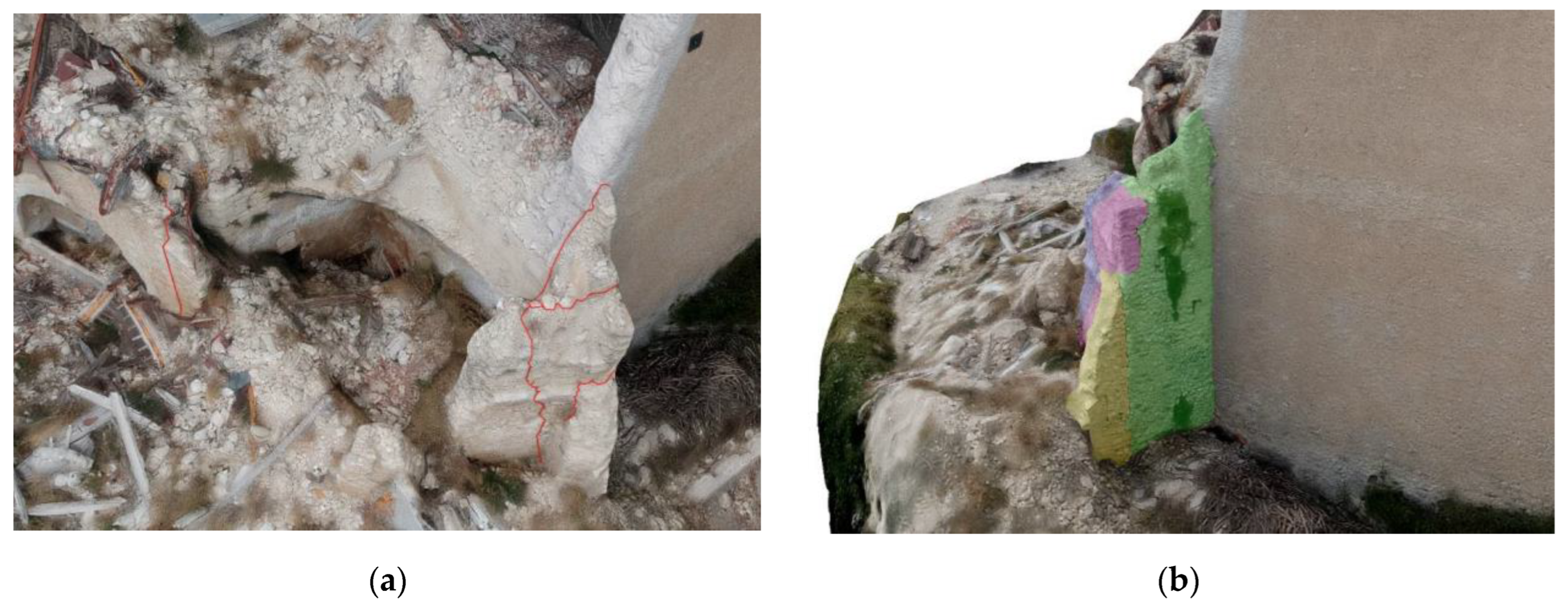
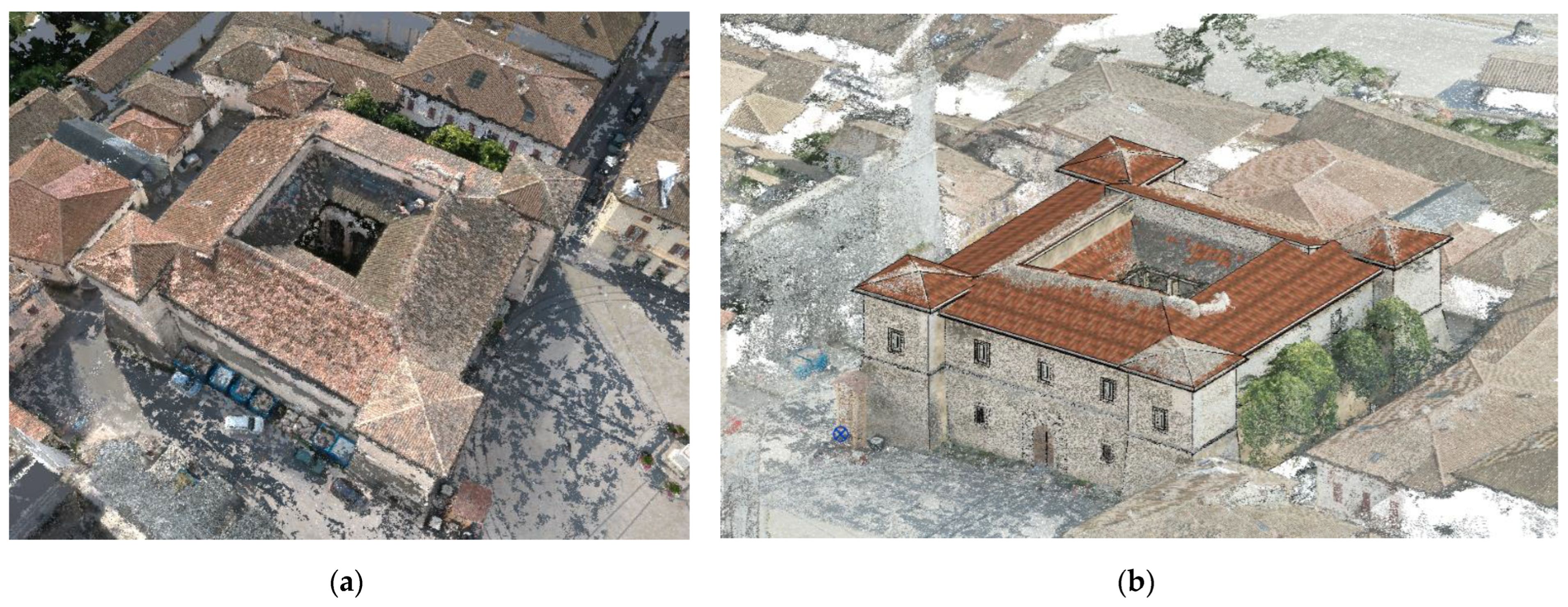
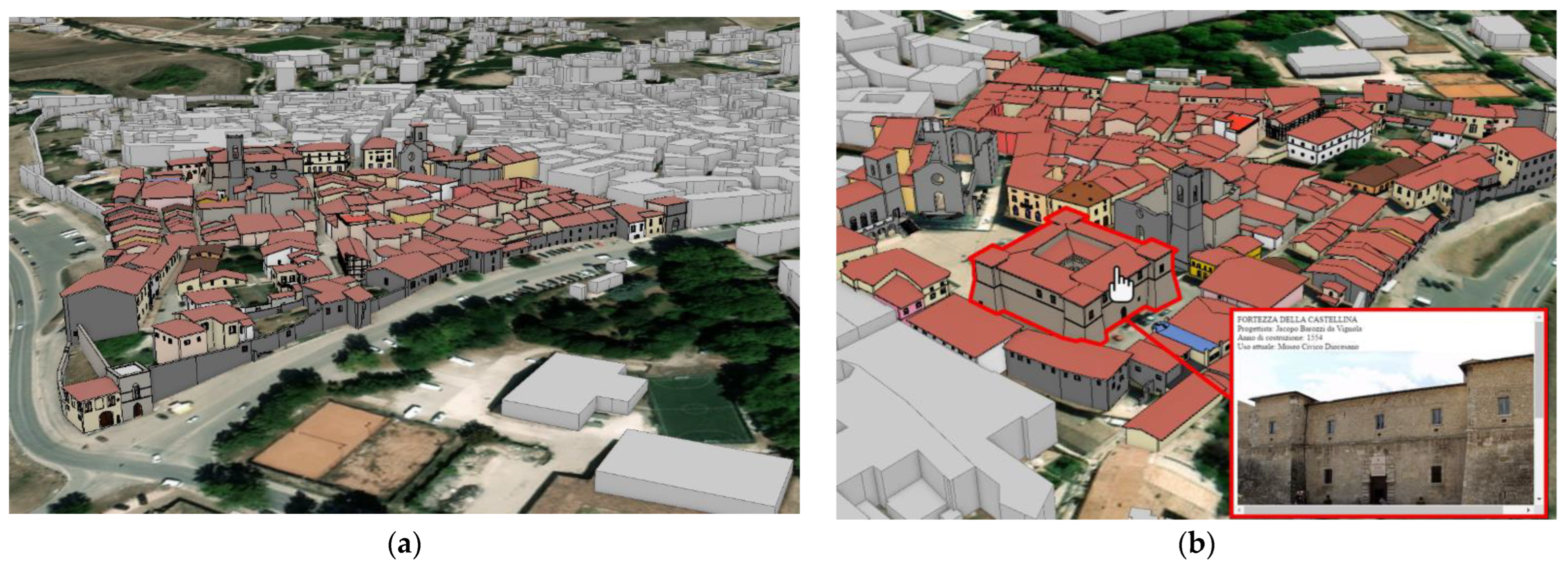
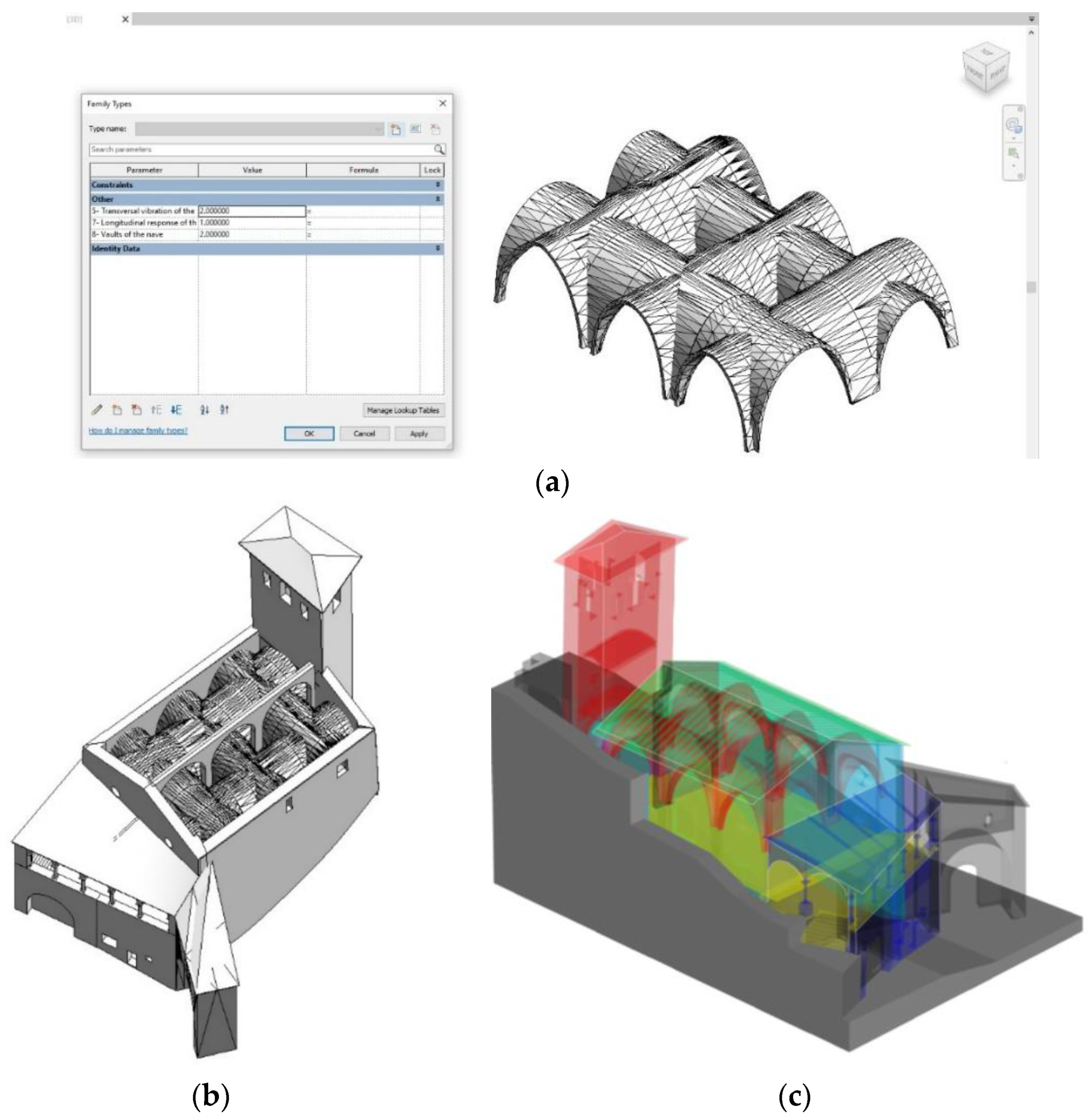
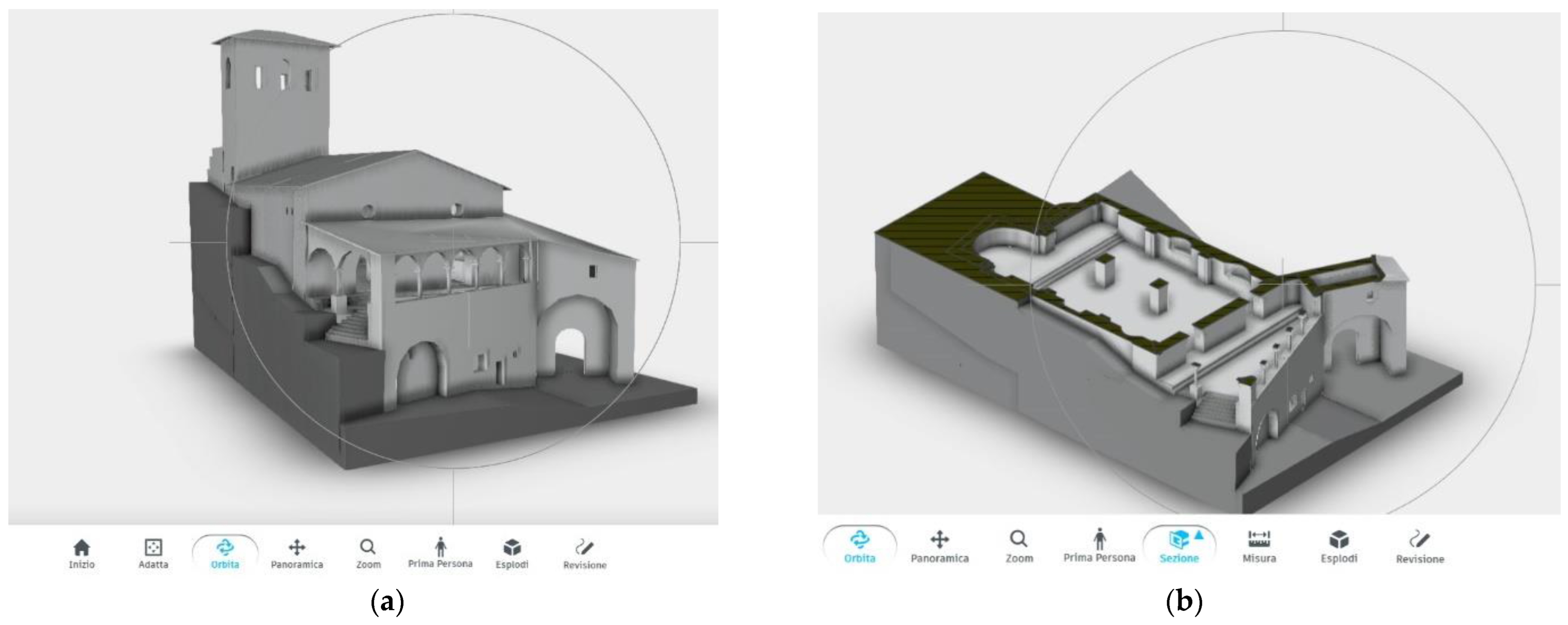

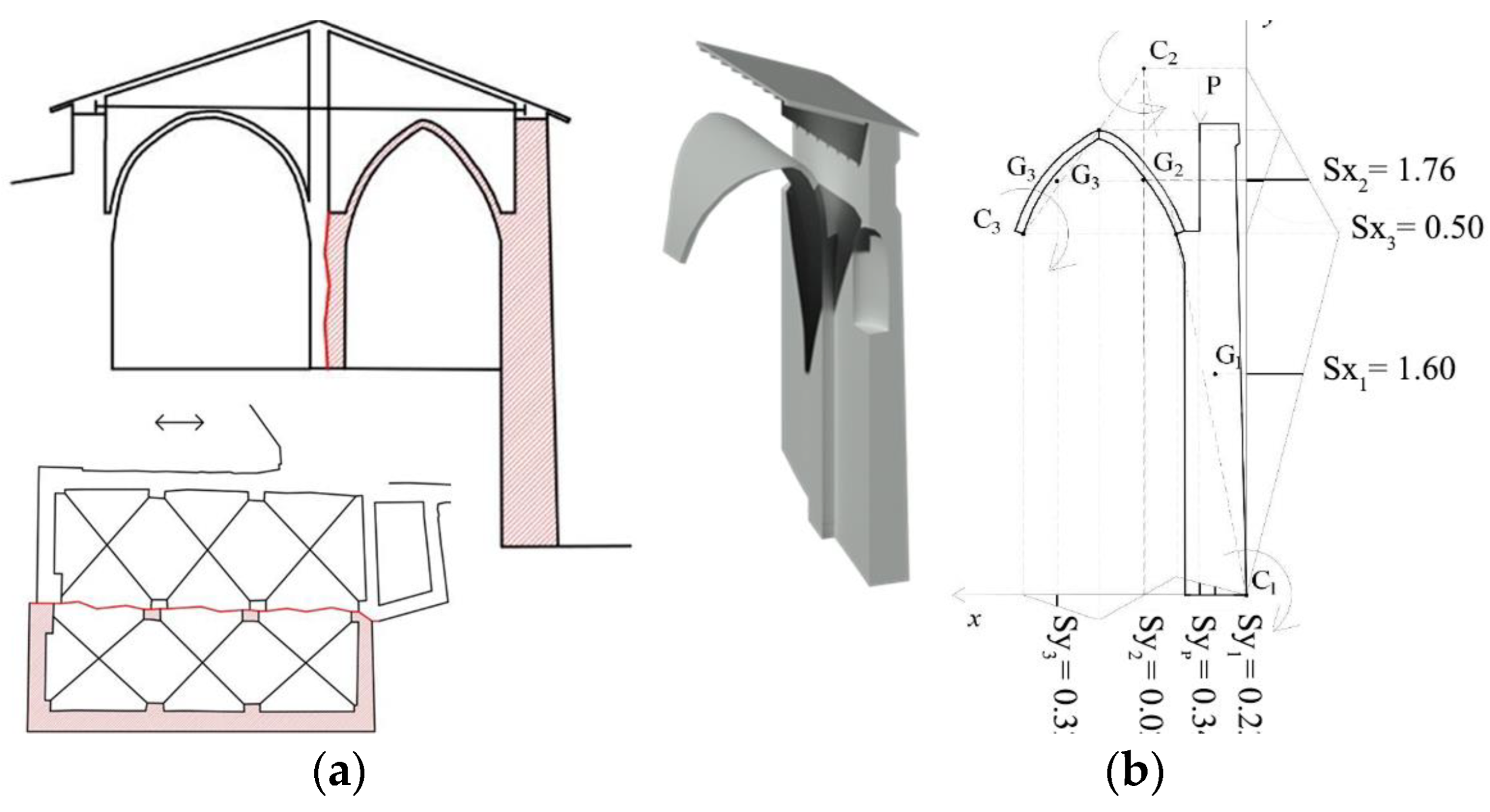
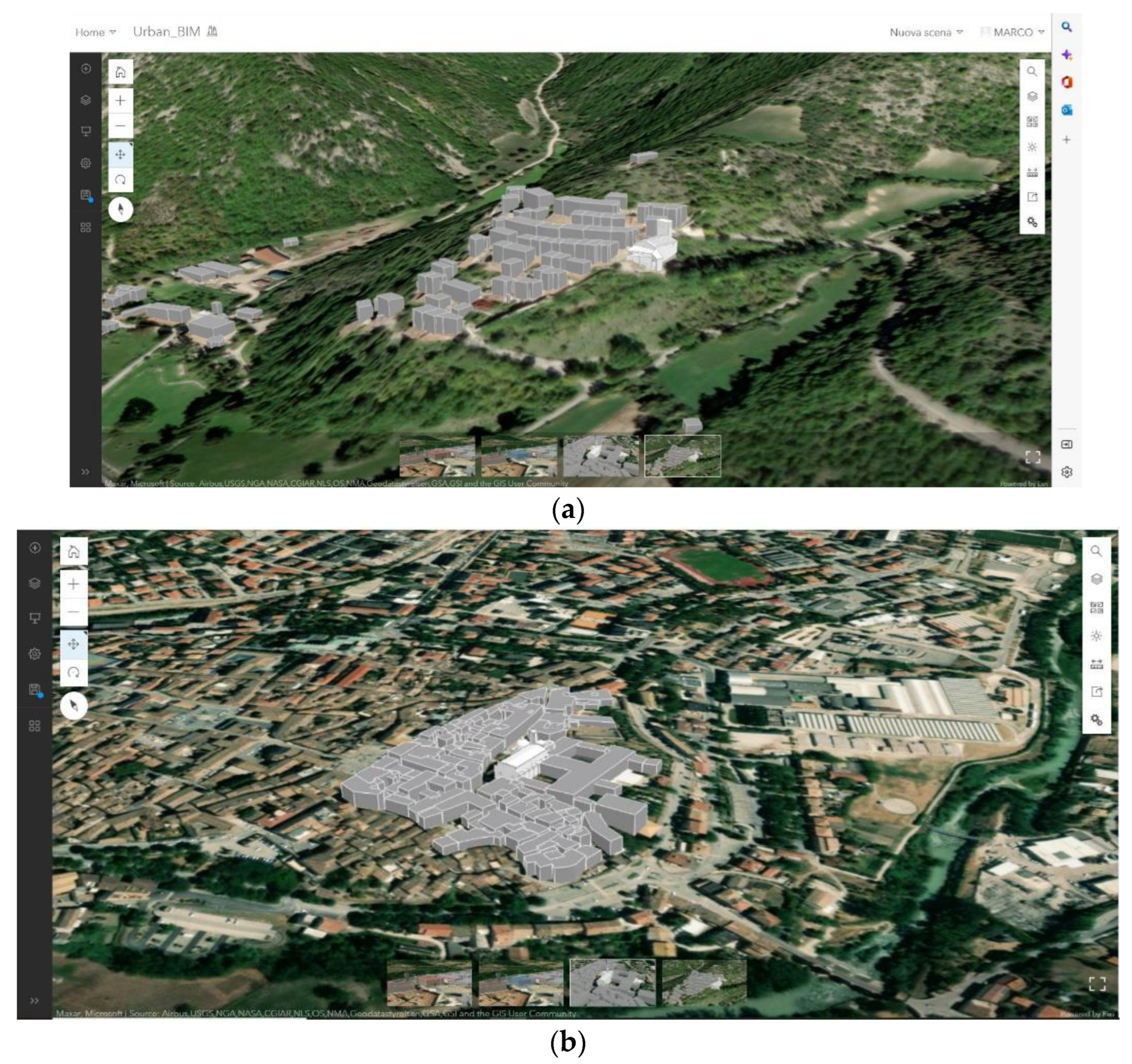
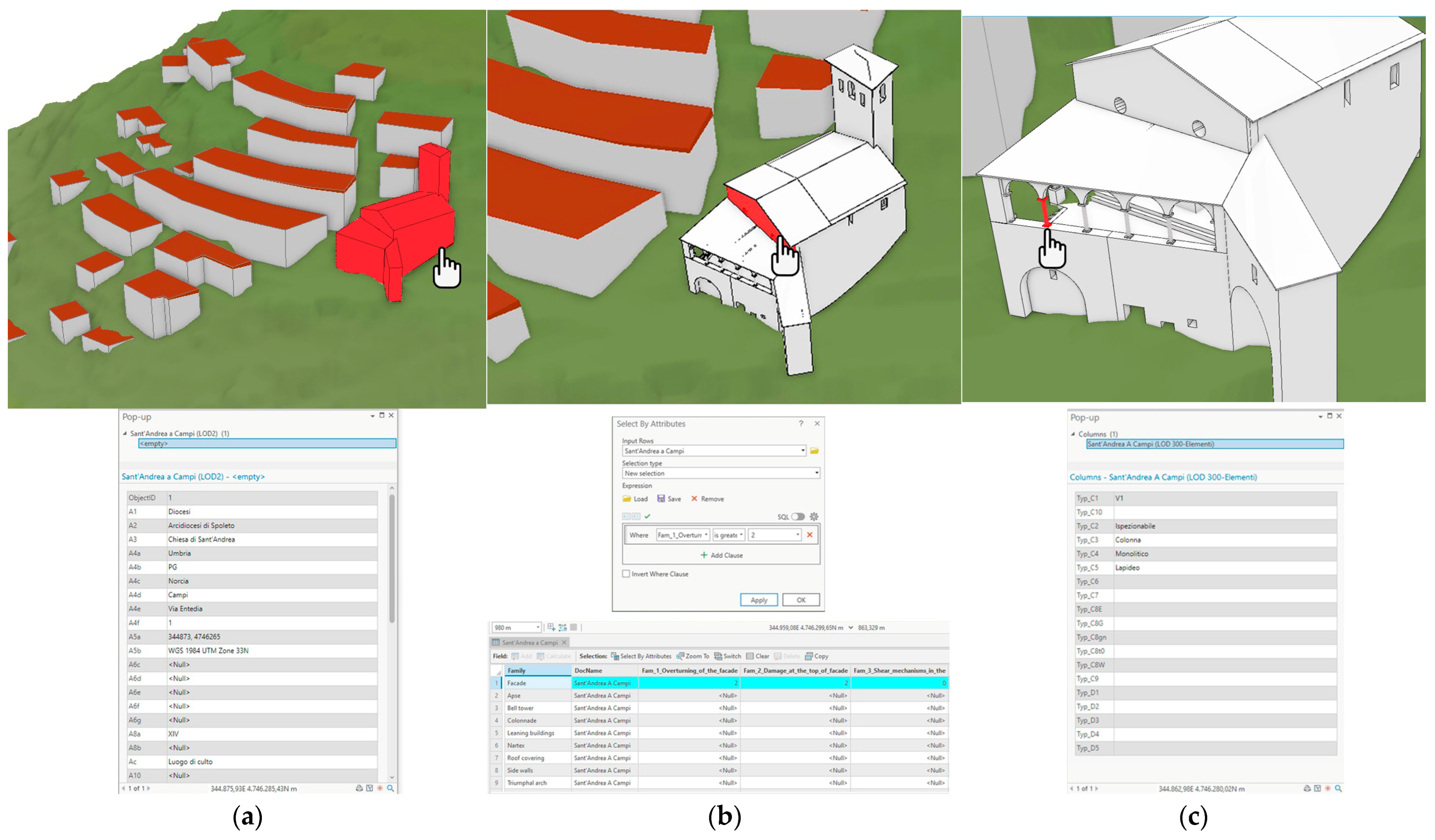
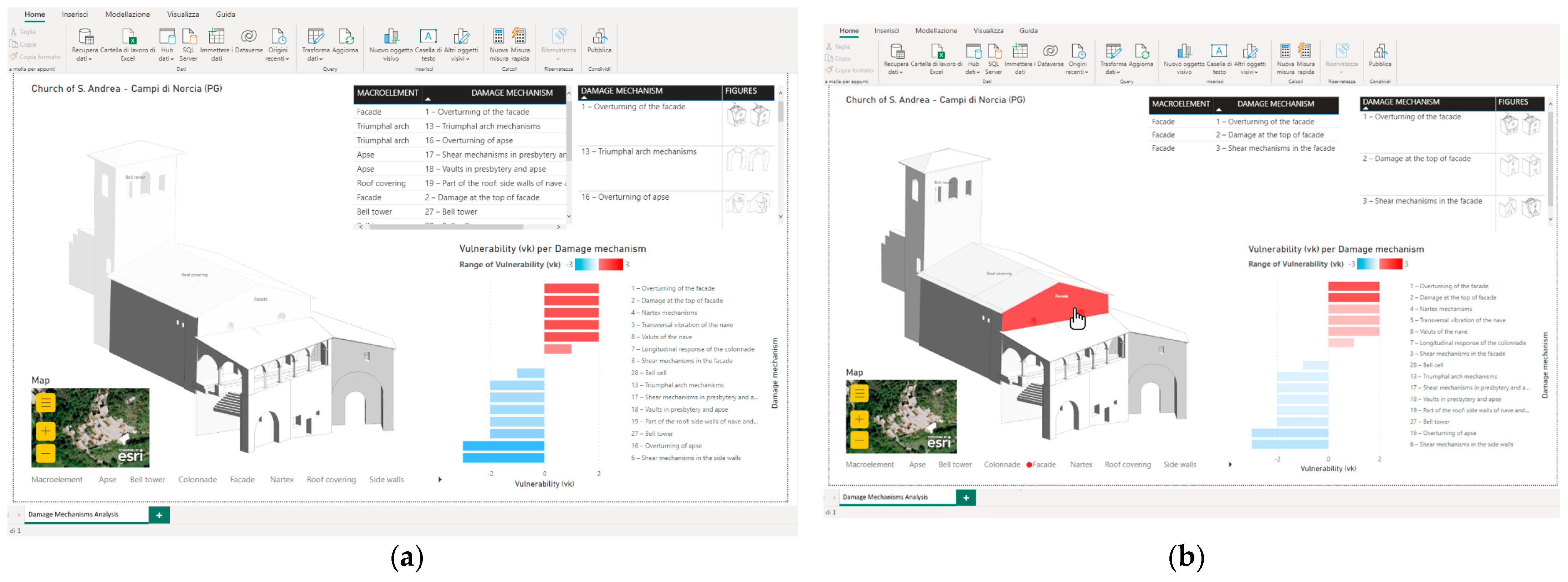

| Directive Modules | Description |
|---|---|
| A | Building identification. It is useful to identify the artifact, base on three fundamental parameters: denomination, toponymy, cadastral data. |
| B | Critical issue related to territorial context. It contains the data necessary to determine the relationships between the building and the territorial context in order to classify particular sensitivity factors. |
| C | Structural elements morphology. It identifies and describes the structural elements, through the recognition of the morphology, typology, construction techniques and materials. |
| D | State of conservation. It classifies and describes the damage phenomena of the individual structural elements. |
| E | Geometric survey. It is intended the survey of the building in its current state, as a complete stereometric description of the building, including any cracking and deformation phenomena |
| F | Former restoration intervention. It identifies to any recorded past action related to structural consolidation |
| G | Historical investigation. It is related to historical data collected on the building phases |
| H | Diagnostic investigation. It refers to the data derived from diagnostic investigation phases |
| Level of Evaluation | Description |
|---|---|
| LV1 | The LV1 level allows the evaluation of the seismic action with simplified methods, based on a limited number of geometric and mechanical parameters or qualitative data (visual examination, understanding of construction features, critical and stratigraphic survey). |
| LV2 | The LV2 level refers to the evaluations to be adopted in case of local interventions in limited areas of the building, individual macro-elements, for which local analysis methods are suggested. In this case the assessment of the seismic action for the entire building is carried out with level LV1 instruments |
| LV3 | The LV3 level allows the design of diffuse interventions in construction through the assessments concerning the entire building or local analysis methods used for the LV2 level, provided that they are generally applied to all the elements of the construction (from past seismic events experience, the collapse event in historic masonry buildings is achieved, in most cases, due to loss of equilibrium of limited portions of the construction, defined as macro-elements). |
| LoD 1/LOD 100 | |
| CityGML definition (2.0 version) | IFC Elements |
| AbstractBuilding is the pivotal class of the model; it is a subclass of the thematic class _Site (and transitively of the root class _CityObject). _AbstractBuilding is specialised either to a Building or to a BuildingPart. | Conceptual mass-elements |
| LoD 2,3,4/LOD 200/300/400 | |
| CityGML definition (2.0 version) | IFC Elements |
| RoofSurface class espress the major roof parts of a building or building part BuildingInstallation class involves secondary parts of a roof with a specific semantic meaning like dormers or chimneys. | IfcRoof:
|
| WallSurface is used to model all parts of the building façade belonging to the outer building shell | IfcWall:
|
| LoD 3,4 /LOD 300/400 | |
| CityGML definition (2.0 version) | IFC Elements |
| Opening: Door/Window is the abstract base class for semantically describing openings like doors or windows in outer or inner boundary surfaces like walls and roofs. | IfcDoor:
|
| BuildingInstallation is a class used for building elements like balconies, chimneys, dormers or outer stairs, strongly affecting the outer appearance of a building | IfcStair:
|
| LOD 400 | |
| City GML definition (2.0 version) | IFC Elements |
| InteriorWallSurface is a class to be used only in the LoD 4 interior building model for modelling the visible surfaces of the room walls. | Constructive elements stratigraphy: The concept template Property Sets for Objects describes how an object occurrence can be related to a single or multiple property sets (that contain a single or multiple properties). The data types of individual property are sigle value, enumerated value, bounded value, table value, reference value, list value, and combination of property occurrences. Property sets can also be related to an object type (Property Sets for Types), that define the common properties for all occurrences of the same type. If the same property (by name) is provided by the same property set (by name), then the properties directly assigned to the object occurrence override the properties assigned to the object type. (https://standards.buildingsmart.org/IFC/DEV/IFC4_2/FINAL/HTML/schema/templates/property-sets-for-objects.htm, accessed on 27 January 2023) |
| Macroelement | Damage Mechanisms | Vulnerability (vk) |
|---|---|---|
| Facade | 1—Overturning of the facade | 2 |
| 2—Damage at the top of facade | 2 | |
| 3—Shear mechanisms in the facade | 0 | |
| Nartex | 4—Nartex mechanisms | 2 |
| Side walls | 5—Transversal vibration of the nave | 2 |
| 6—Shear mechanisms in the side walls | −3 | |
| Colonnade | 7—Longitudinal response of the colonnade | 1 |
| Vaults | 8—Valuts of the nave | 2 |
| Triumphal arch | 13—Triumphal arch mechanisms | −2 |
| Apse | 16—Overturning of apse | −3 |
| 17—Shear mechanisms in presbytery and apse | −2 | |
| 18—Vaults in presbytery and apse | −2 | |
| Roof covering | 19—Part of the roof: side walls of nave and aisles | −2 |
| Bell tower | 27—Bell tower | −2 |
| 28—Bell cell | −1 |
| Name | Parameter | Value | Reference Value |
|---|---|---|---|
| Vulnerability index | iv | 0.45 | 0–1 |
| Peak ground acceleration SLD | aSLD | 0.051 g | 0.444 g expected |
| Peak ground acceleration SLV | aSLV | 0.203 g | 0.444 g expected |
| Nominal lifetime 1 | VN | 2 years | >20 years |
| Safety index | IS | 0.04 | >1 |
| Damage Mechanisms | Trigger Mechanism Value | Reference Value |
|---|---|---|
| Overturning of the south side wall | 0.296 g | 0.444 g expected |
| Overturning of the bell tower | 0.632 g | 0.444 g expected |
| LoD/LOD | Directive Tasks | Description |
|---|---|---|
| LoD 0 | A B | Building identification (cartography, cadastre)—2D Criticality factors of the building in relation to the territorial context |
| LoD 1/LOD 100 | A B | Building identification (cartography, cadastre)—3D Criticality factors of the building in relation to the territorial context |
| LoD 2/LOD 200 | E F LV1 LV2 | Geometric survey—3D Former restoration actions—4D Parameters resulting from the LV1 assessment relating to the macroelements Parameters resulting from the LV2 assessment relating to the macroelements |
| LoD 3,4/LOD 300/400 | C D F G H LV2 LV3 | Elements morphology—3D State of conservation of elements—3D Former restoration actions—4D Historical investigation—4D Diagnostic investigation—4D Parameters resulting from the LV2 assessment relating to the elements Parameters resulting from the LV3 assessment relating to the elements |
Disclaimer/Publisher’s Note: The statements, opinions and data contained in all publications are solely those of the individual author(s) and contributor(s) and not of MDPI and/or the editor(s). MDPI and/or the editor(s) disclaim responsibility for any injury to people or property resulting from any ideas, methods, instructions or products referred to in the content. |
© 2023 by the authors. Licensee MDPI, Basel, Switzerland. This article is an open access article distributed under the terms and conditions of the Creative Commons Attribution (CC BY) license (https://creativecommons.org/licenses/by/4.0/).
Share and Cite
Sammartano, G.; Avena, M.; Fillia, E.; Spanò, A. Integrated HBIM-GIS Models for Multi-Scale Seismic Vulnerability Assessment of Historical Buildings. Remote Sens. 2023, 15, 833. https://doi.org/10.3390/rs15030833
Sammartano G, Avena M, Fillia E, Spanò A. Integrated HBIM-GIS Models for Multi-Scale Seismic Vulnerability Assessment of Historical Buildings. Remote Sensing. 2023; 15(3):833. https://doi.org/10.3390/rs15030833
Chicago/Turabian StyleSammartano, Giulia, Marco Avena, Edoardo Fillia, and Antonia Spanò. 2023. "Integrated HBIM-GIS Models for Multi-Scale Seismic Vulnerability Assessment of Historical Buildings" Remote Sensing 15, no. 3: 833. https://doi.org/10.3390/rs15030833
APA StyleSammartano, G., Avena, M., Fillia, E., & Spanò, A. (2023). Integrated HBIM-GIS Models for Multi-Scale Seismic Vulnerability Assessment of Historical Buildings. Remote Sensing, 15(3), 833. https://doi.org/10.3390/rs15030833








